I’m a docent at Pima Air & Space Museum, where I conduct tram tours of our outdoor display aircraft. When welcoming visitors at the start of the tour, I ask if anyone wants to know more about any particular airplane. Nine times out of ten, the one people want to hear about is our former Air Force One, a VC-118 (Douglas DC-6) used by Presidents Kennedy and Johnson.
I wrote about the museum’s presidential fleet aircraft in an earlier post, describing their history and that of other Air Force One aircraft. Since then I’ve learned more about these famous planes, in the process clarifying (and sometimes correcting) what I knew before.
I’ll share that knowledge in this and future posts, but frankly, I’m mostly doing it for me. With so many airplanes to talk about in just one hour, I can only give a few seconds to each. When it comes to the Air Force One, I simplify the story and skip over details. Every now and then, though, a visitor will want to know the details, and I need to be sure I’m able to give the correct answer.
This is Pima Air & Space Museum’s Air Force One:
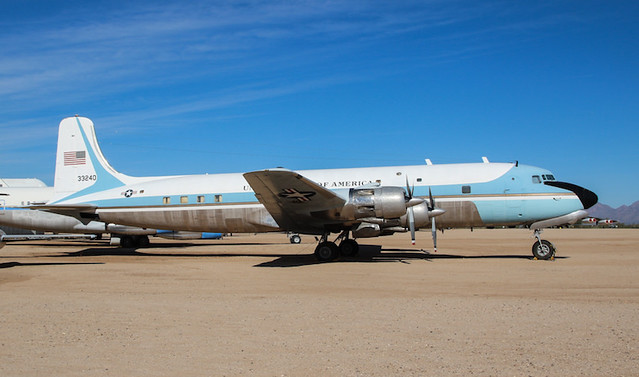
Folklore has it this was JFK’s favorite plane, despite having a jet Air Force One at his disposal. I don’t know if it really was. I do know the early presidential jets needed long runways. The piston & prop powered VC-118 didn’t, so it got a lot of use, not only for visits to American cities with small airports, but also for family trips home: Hyannisport for the Kennedys, Austin for the Johnsons.
Prior to the Kennedys, there was no standard paint scheme for presidential aircraft. Roosevelt’s C-54, the Sacred Cow, was polished aluminum. Truman’s VC-118, a plane similar to the one at Pima Air & Space, had a fancy paint job with an eagle motif. Eisenhower went back to polished aluminum with his two VC-121 Lockheed Constellations, Columbine II and III.
 |
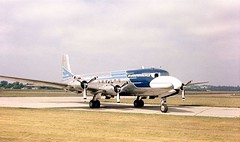 |
 |
In the last year of Eisenhower’s presidency, 1959, the USAF purchased three new Boeing 707-120s for the presidential fleet (the USAF’s 89th Special Airlift Wing, which provides airlift for the president, vice president, combat commanders, and other senior government officials). These three aircraft, designated VC-137As (later upgraded to VC-137Bs when the engines were replaced with more powerful ones), were called Special Air Mission (SAM) 970, 971, and 972 (as a side note, SAM 971 is also on display at Pima Air & Space).
They were the first aircraft to wear this new USAF VIP livery:
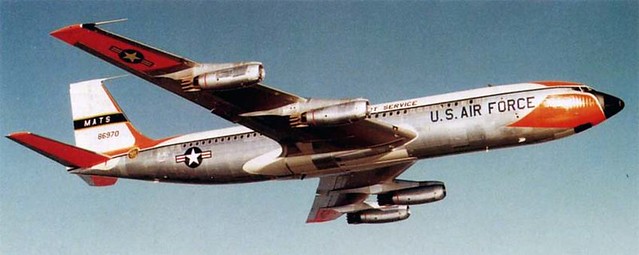
Certainly, this was a substantially different look from the blue & white Air Force One paint scheme we know today, which was introduced by the Kennedys in 1962.
The USAF didn’t intend for the first three jets to be presidential aircraft. They were purchased as general-purpose VIP transports. While they had 40-passenger executive seating and sophisticated communications equipment, they lacked other features the USAF wanted in its first jet age Air Force One. That airplane, an extended-range Boeing 707-353B, had been contracted for and was under construction, but would not be delivered until late 1962.
Regardless of USAF intentions, all three VC-137s, but especially SAM 970 (nicknamed “Queenie”), were used as Air Force Ones by Eisenhower and Kennedy. Ike used Queenie during his final year in office and JFK used it up until October 1962, when the new 707-353B, the famous VC-137C known as SAM 26000, was delivered. At that point SAM 26000 became the official Air Force One aircraft and the three VC-137s reverted to general VIP use, remaining in the presidential fleet until 1996, transporting vice presidents and other high-ranking officials.
I love to tell museum visitors about the origin of the distinctive and universally-recognizable blue & white livery worn by Air Force One, starting with the story of the red & white paint on Queenie and its sister ships. This story too is a mixture of folklore and fact, but I’m getting closer to the facts. Every time a visitor asks me a question about the paint I do a little more research in order to give a better answer to the next visitor, and I’m at the point now where I think I have it pretty much straight.
Eisenhower was fine with Queenie’s red & white markings. Kennedy, though, was not (some historians say he thought the colors were “too imperial”). Jackie, presumably, didn’t like it either. Nor did the new first family like its “U.S. Air Force” and “Military Air Transport Service” markings. Even before going to work on the exterior design of the new Air Force One to be delivered in 1962, they had the old markings removed from Queenie and its sister ships, replaced with a “United States of America” logo on the top of the fuselage and a prominent American flag on the tail, the better to represent the nation, not just the USAF.

Air Force One’s blue & white livery, the distinctive design we know today, was created by French-American industrial designer Raymond Loewy (famous for the Studebaker Champion and Avanti, the Coca-Cola bottle, the paint scheme of the Greyhound Bus Scenicruiser, and the Lucky Strike logo). Some say Jackie hired Loewy, some say Loewy approached the White House on his own. From all I can put together, while Loewy was nominally in charge of designing the new Air Force One, both the president and first lady were involved at all stages of the process.

You can see that Loewy retained some red in his initial design. The USAF, fearful of potential mid-air collisions, wanted red markings to make the aircraft more visible in the air. It was JFK himself who insisted on getting rid of red altogether. It was also JFK who suggested the font for the prominent United States of America lettering on top, the same font used in the header of the Declaration of Independence.
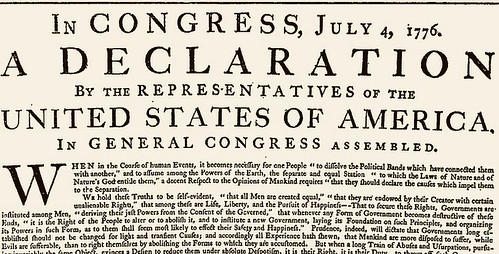
Loewy’s design, first seen on the new Air Force One delivered in October 1962, featured polished aluminum on the wings and lower fuselage; slate blue under the nose and on the engine nacelles; a gold stripe below the cabin windows (the gold stripe, they say, was Jackie’s touch); a darker shade of blue (cyan) above the cockpit, down the middle of the fuselage, and on the tail; white on top of the fuselage; and presidential seals on both sides of the nose.

After the new Air Force One, SAM 26000, was fielded in October 1962, the older Air Force Ones—the VC-118 and VC-137s—were repainted in the new livery. Loewy’s design became the standard for subsequent Air Force Ones, including the VC-25 Boeing 747s in use today.
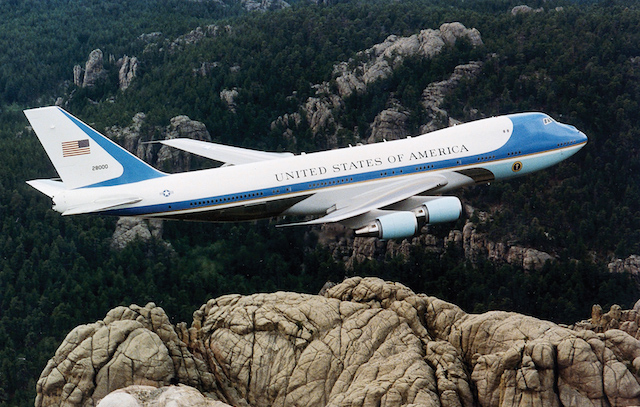
Although presidents can and do fly on other presidential fleet aircraft as the need arises, only those aircraft specifically designated for presidential travel wear the full Air Force One livery. Other aircraft in the presidential fleet, the ones used for general VIP travel, have similar but different paint, minus the two-tone blue and presidential seals.
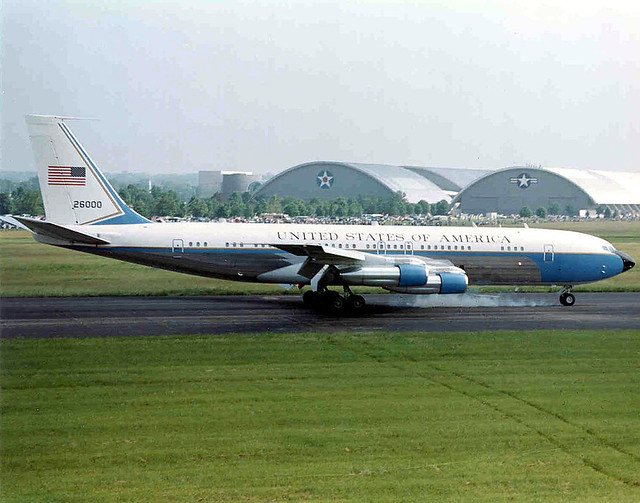
No matter what airplane the president flies in, its call sign is Air Force One. There’s a story there too, which I share with museum visitors. Back in the day, presidential aircraft used standard USAF call signs, an “Air Force” prefix followed by the aircraft tail number. Eisenhower’s Columbine II, the Lockheed Connie he used during his first term in office, flew under the call sign “Air Force 8610.” This was fine, so the story goes, until the day Ike and Air Force 8610 entered the same airspace as United Flight 8610, and an air traffic controller came up on the radio to ask which was which. A Secret Service officer flying with the president heard the radio call and became concerned. He shared his concern with Eisenhower’s staff, and thus was born “Air Force One,” a call sign that cannot be confused with any other.
That’s the story, anyway. Certainly, some kind of incident involving Air Force 8610 and United Flight 8610 did occur, and everyone agrees it led to the creation of the Air Force One callsign. Folklore comes in with the details. It either happened in the airspace over New York City, or somewhere over Florida, or over Virginia while Ike was flying to North Carolina to give a speech. It either happened in 1953 or 1954. The truth is out there somewhere. And I will eventually root it out!
I’ll close with a bonus photo of the Kennedys disembarking from one of the old red & white Air Force Ones, in happier times, May of 1962.
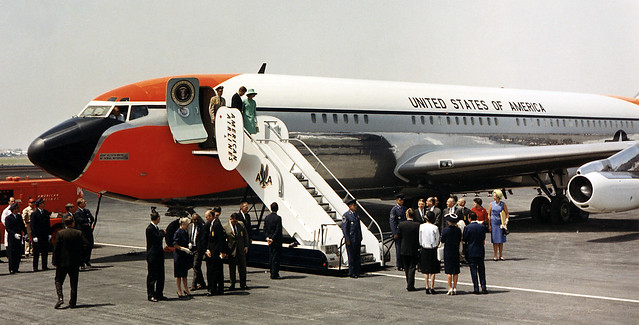
Update (5/25/18): Here’s an interesting tidbit about Eisenhower and Queenie, the first jet Air Force One, received today from a fellow PASM docent:
“During 1959 CIA Director Allen Dulles proposed that the president’s personal airplane—Air Force One—be secretly configured to take photographs during Eisenhower’s planned 1960 trip to Moscow. …
“Dulles did not tell the president of the Air Force One project—undertaken by Lockheed Aircraft Services at their Jamaica, New York, facility and named LIDA ROSE—in an effort to allow Eisenhower the political option of ‘plausible deniability’ should the airplane’s intelligence-gathering capabilities be compromised. … Air Force One’s co-pilot was the camera operator. Test flights demonstrated the success of the project, estimated to cost $1,000,000, and the airplane was readied for the president’s trip to Moscow.
“All for naught! The shoot-down of Francis Gary Powers, 01 May 1960, scuttled the trip.
“The camera gear remained in Air Force One until January 1961, when John Kennedy took office.”
Satellites were on the brink of replacing U-2 overflights. “…it is ironic that Eisenhower himself would have been aboard the last US reconnaissance overflight of the Soviet Union.”
Ref:
SPYFLIGHTS AND OVERFLIGHTS
US Strategic Aerial Reconnaissance
Vol 1: 1945-1960
p 107-109
The above information is footnoted 86:
J F terHorst, and Ralph Albertazzie
THE FLYING WHITE HOUSE: The Story of Air Force One
(New York: Coward, McCann & Geoghegan, 1979), 195-98
Update (11/16/18): During my docent checkout, I was told that PASM’s VC-137B, SAM 971, had never been used to transport a sitting president. It turns out all three of the VC-137s delivered to the Eisenhower administration in 1959 were at different times used by Presidents Eisenhower and Kennedy. So it transpires that Pima Air & Space has two, not one, former Air Force Ones on display. I updated the paragraphs in the original post dealing with those aircraft. Here, for good measure, is a photo of JFK, freshly disembarked from SAM 971, the same plane now on display at PASM:
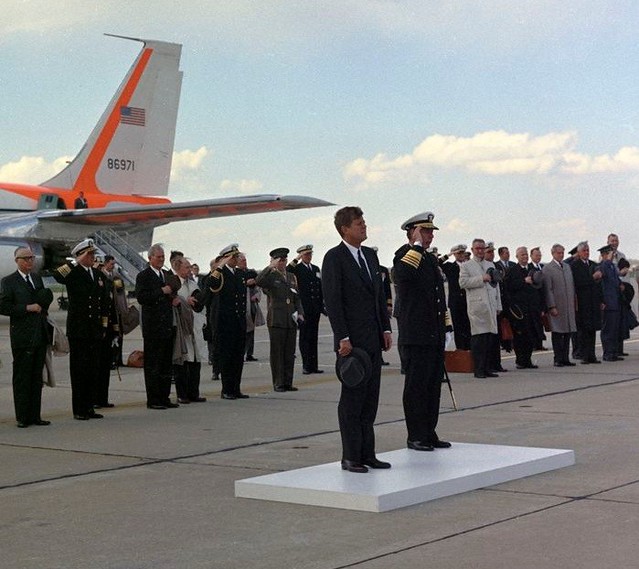
I put this post up on Feb 26, 2018, and modified it slightly today, Feb 27. I found better photos of Queenie, the first jet Air Force One, before and after JFK had its original markings changed.
There are 3 former AF1 aircraft. The Gulfstream in the VIP line at PASM was referred to as AF 1/2 by Johnson. BTW I’m also a former PASM trammer
Sorry not Gulfstream. Lochheed Jetstar